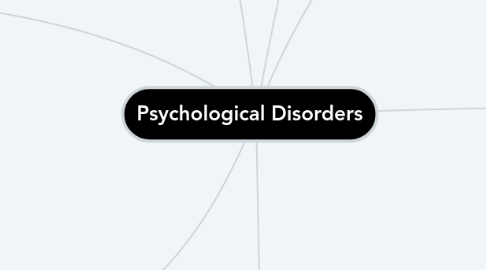
1. Dissociative Disorders
1.1. Characterized by an individual becoming dissociated, from her core sense of self. Memory and identity become disturbed. These disturbances have a psychological cause.
1.1.1. DISSOCIATIVE AMNESIA: The individual is unable to recall important personal information. (They may even forget who they are and adopt another identity for a few hours or days).
1.1.1.1. Usually caused by extremely stressful or traumatic experiences.
1.1.2. DEPERSONALIZATION/DEREALIZATION DISORDER: Depersonalization: The person believes his/her movements, thoughts and feelings are not their own. Derealization: The person feels that the world surrounding them is not real.
1.1.3. DISSOCIATIVE IDENTITY DISORDER: People with dissociative identity disorder exhibit two or more identities, each distinct from one another.
1.1.3.1. Causes: About 95% of people with DID were physically and/or sexually abused as children
2. Personality Disorders
2.1. People with personality disorders exhibit a personality style that differs markedly from the expectations of their culture, is pervasive and inflexible, begins in adolescence or early adulthood, and causes distress or impairment
2.1.1. The DSM-5 recognizes 10 personality disorders, organized into 3 different clusters:
2.1.1.1. Disorders include paranoid personality disorder, schizoid personality disorder, and schizotypal personality disorder. People with these disorders display a personality style that is odd or eccentric.
2.1.1.2. Disorders include antisocial personality disorder, histrionic personality disorder, narcissistic personality disorder, and borderline personality disorder. People with these disorders usually are impulsive, overly dramatic, highly emotional, and erratic.
2.1.1.3. Disorders include avoidant personality disorder, dependent personality disorder, and obsessive-compulsive personality disorder. People with these disorders often appear to be nervous and fearful.
3. Schizophrenia
3.1. Psychotic disorder where the person’s thoughts, perceptions, and behaviors are impaired to the point where he/she is not able to function normally in life.
3.1.1. SYMPTOMS: Hallucination Delusions Disorganized thinking Disorganized or abnormal motor behavior Negative symptoms
3.1.2. Causes: Genetic vulnerability and environmental stress Obstetric complications Marijuana use.
4. Obsessive-Compulsive and Related Disorders
4.1. Involve intrusive, unpleasant thoughts and repetitive behaviors to a status so intense that disrupt daily life.
4.1.1. OBSESSIVE-COMPULSIVE DISORDER: Experiencing thoughts and obsessive unwanted urges, that create a need need to engage in repetitive behaviors or mental acts (compulsions).
4.1.2. BODY DYSMORPHIC DISORDER: The person is preoccupied with a perceived flaw in their physical appearance that is either nonexistent or barely noticeable to other people.
4.1.3. HOARDING DISORDER: People with hoarding disorder cannot get rid of personal possessions, regardless of how valueless or useless these possessions are.
5. Anxiety Disorders
5.1. Most common mental disorder, Approximately 25%–30% of the U.S. population has experienced it. Anxiety will help us prepare or avoid
5.1.1. PHOBIAS: “Intense, unreasonable and persistent fear caused by the presence or anticipation of a specific object or situation.”
5.1.2. GENERALIZED ANXIETY DISORDER: Continuous state of excessive, uncontrollable, and pointless worry and apprehension.
5.1.3. SOCIAL ANXIETY DISORDER: Extreme and persistent fear or anxiety and avoidance of social situations in which the person could potentially be evaluated negatively by others.
5.1.4. PANIC DISORDER: Unreasonable episode characterized by feeling like you´re going to die. You begin sweating and trembling, your heart starts pounding, you have trouble breathing, it can last up to 10 min.
6. Trauma-and-Stressor-Related Disorders
6.1. POST- TRAUMATIC STRESS DISORDER: Extremely stressful or traumatic events, such as combat, natural disasters, and terrorist attacks, place people at an increased risk for developing psychological disorders such as posttraumatic stress disorder (PTSD).
7. Mood Disorders
7.1. MAJOR DEPRESSIVE DISORDER: Syntomps: loss of interest and pleasure in usual activities. Feeling overwhelmingly sad most of each day. No interest or enjoyment in activities that previously were gratifying
7.1.1. To receive a diagnosis you must present least five symptoms for at least a two-week period: -----Significant weight loss (when not dieting) or weight gain and/or significant decrease or increase in appetite; -Difficulty falling asleep or sleeping too much; -Psychomotor agitation or psychomotor retardation; -Fatigue or loss of energy; -Feelings of worthlessness or guilt; -Difficulty concentrating and indecisiveness; and -Suicidal ideation or attempt.
7.1.2. Subtypes of depression include: -Seasonal pattern -Postpartum depression -Persistent depressive disorder: depressed moods most of the day nearly every day for at least two years, as well as at least two of the other symptoms.
7.1.3. Most people recover from Major Depression within a year but their chances to get another episode increase each time they have one. It is more common among women than among men, affecting approximately 20% of women and 13% of men at some point in their life.
7.2. BIPOLAR DISORDER: The person often experiences mood states that vacillate between depression and mania.
7.2.1. manic episode: period of abnormally and persistently elevated, expansive, or irritable mood and abnormally and persistently increased activity or energy lasting at least one week,” that lasts most of the time each day.
7.2.2. SYNTOMPS:Mood that is almost euphoric. Excessively talkative. Spontaneously starting conversations with strangers. Excessively irritable. Abruptly switching from one topic to another. May exhibit grandiosity. Engage in recklessly pleasure activities that could have harmful consequences. (Gambling, reckless driving, etc.)
